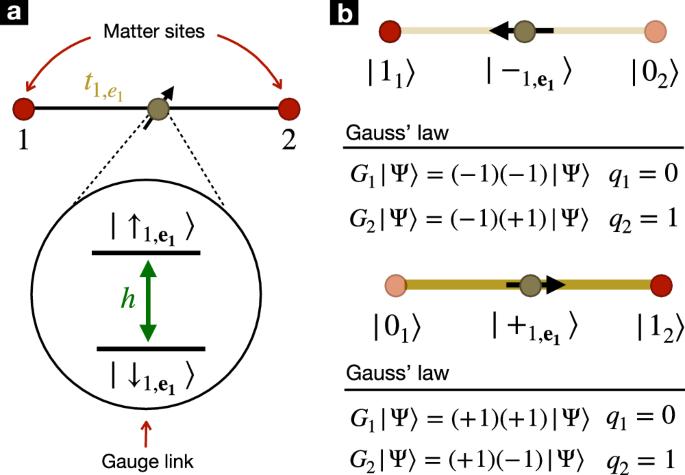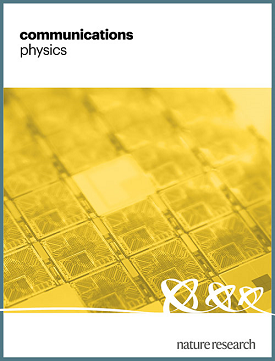基于被困离子参数激发的合成 ${{mathbb{Z}}}_{2}$ 计理论
IF 5.4
1区 物理与天体物理
Q1 PHYSICS, MULTIDISCIPLINARY
引用次数: 0
摘要
晶格规理论量子模拟的资源高效方案可以受益于使用原生自由度的规场和物质场混合编码,如困离子器件中的内部量子比特和运动声子。我们建议使用参数方案来诱导内部量子比特态条件下的声子隧道,当使用单个被困离子实现时,它对应于最小的 $${{{mathbb{Z}}}_{2}$ 轨则理论。为了评估这一方案的可行性,我们使用现实参数对依赖于状态的隧道进行了数值模拟,并确定了未来实验中的主要误差源。我们讨论了如何通过增加离子数量、从单链到 $${{\mathbb{Z}}}_{2}$ plaquette 以及整个 $${{\mathbb{Z}}}_{2}$ 链,将这种最小情况推广到更复杂的设置。我们提出了量规不变动力学和相应约束的分析表达式,并利用矩阵乘积态模拟作为基准。量规理论量子模拟器的一个突出问题是找到可行的方案,使我们能够从初始原型迈向大规模体系。在这项工作中,作者利用困离子系统,为与动力学物质耦合的 Z2 格规理论量子模拟器提出了一个详细的工具箱,可以克服这些限制。本文章由计算机程序翻译,如有差异,请以英文原文为准。

Synthetic $${{\mathbb{Z}}}_{2}$$ gauge theories based on parametric excitations of trapped ions
Resource efficient schemes for the quantum simulation of lattice gauge theories can benefit from hybrid encodings of gauge and matter fields that use the native degrees of freedom, such as internal qubits and motional phonons in trapped-ion devices. We propose to use a parametric scheme to induce a tunneling of the phonons conditioned to the internal qubit state which, when implemented with a single trapped ion, corresponds to a minimal $${{\mathbb{Z}}}_{2}$$ gauge theory. To evaluate the feasibility of this scheme, we perform numerical simulations of the state-dependent tunneling using realistic parameters, and identify the leading sources of error in future experiments. We discuss how to generalize this minimal case to more complex settings by increasing the number of ions, moving from a single link to a $${{\mathbb{Z}}}_{2}$$ plaquette, and to an entire $${{\mathbb{Z}}}_{2}$$ chain. We present analytical expressions for the gauge-invariant dynamics and the corresponding confinement, which are benchmarked using matrix product state simulations. An outstanding question for gauge-theory quantum simulators is to find viable schemes that allow one to move from the initial prototypes towards the large-scale regime. In this work, the authors present a detailed toolbox for the quantum simulator of Z2 lattice gauge theories coupled to dynamical matter using trapped-ion systems that can overcome these limitations.
求助全文
通过发布文献求助,成功后即可免费获取论文全文。
去求助
来源期刊

Communications Physics
Physics and Astronomy-General Physics and Astronomy
CiteScore
8.40
自引率
3.60%
发文量
276
审稿时长
13 weeks
期刊介绍:
Communications Physics is an open access journal from Nature Research publishing high-quality research, reviews and commentary in all areas of the physical sciences. Research papers published by the journal represent significant advances bringing new insight to a specialized area of research in physics. We also aim to provide a community forum for issues of importance to all physicists, regardless of sub-discipline.
The scope of the journal covers all areas of experimental, applied, fundamental, and interdisciplinary physical sciences. Primary research published in Communications Physics includes novel experimental results, new techniques or computational methods that may influence the work of others in the sub-discipline. We also consider submissions from adjacent research fields where the central advance of the study is of interest to physicists, for example material sciences, physical chemistry and technologies.
 求助内容:
求助内容: 应助结果提醒方式:
应助结果提醒方式:


